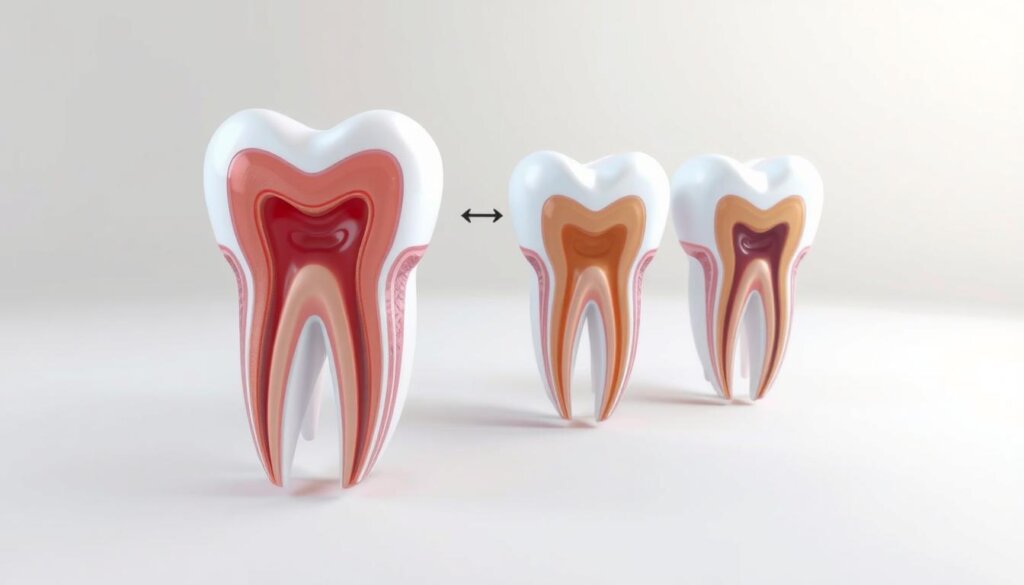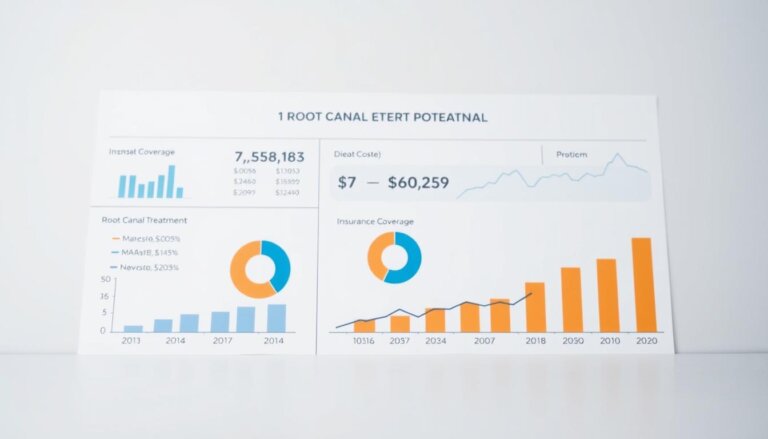Post-Root Canal Pain Duration – What to Expect
Most people feel only mild to moderate soreness after a root canal. Many start to feel better in just a few days. Dental experts at Cleveland Clinic say new techniques help keep the tooth safe and reduce pain.
Many wonder, Will I feel pain after the root canal, and for how long? This article looks at how long pain usually lasts. It also talks about what affects pain levels and when to see a dentist if pain doesn’t go away.
Key Takeaways
- Root canal pain usually decreases within days.
- Modern methods lessen overall discomfort.
- Some mild swelling is common during healing.
- OTC pain relievers often provide relief.
- Consult a dentist if severe pain persists.
Understanding Root Canal Procedures
Many patients wonder, Will I feel pain after the root canal? Modern dentistry uses advanced anesthetics to reduce pain. Medical News Today says today’s methods make root canals as painless as a basic filling.
This procedure removes infected pulp and cleans the tooth’s inner chamber. It helps keep the tooth’s natural structure safe. It also prevents future problems for those seeking long-term relief.
What Is a Root Canal?
A root canal targets the tooth’s center, where decay or infection can spread. Specialists pinpoint this vulnerable area to protect healthy tissue. Key steps include:
- Removing infected pulp
- Thoroughly cleaning and sealing the canal
- Preserving the tooth with a suitable filling or crown
Why Are Root Canals Necessary?
Untreated infection can cause abscesses or serious problems. A root canal keeps chewing function and prevents tooth extraction. It promotes lasting oral health and solves persistent soreness at its source.
Typical Pain After a Root Canal
After a root canal, you might feel some swelling and tenderness. Many people feel better once the infected tissue is gone. But, it can take a little time for your gums to adjust.
Sensitivity is common, but most people start to feel more comfortable over time.
Common Symptoms Following the Procedure
Your gums might feel tender near the treated tooth. You might feel a dull ache when you bite down. Sometimes, you might feel short periods of discomfort, mainly if your local tissues were inflamed.
These symptoms usually get better with the right care.
- Mild swelling around the tooth
- Sensitivity to temperature changes
- Occasional throbbing in the jaw
Factors Influencing Pain Levels
How fast you heal depends on your history, immune system, and how bad the infection was. If you manage the inflammation well, you might heal faster. A good treatment plan helps you get back to normal sooner.
| Factor | Impact on Discomfort |
|---|---|
| Severity of Infection | Deep decay tends to demand a longer recovery. |
| Overall Health | Chronic conditions may slow tissue repair. |
| Oral Hygiene | Steady brushing and flossing reduce post-procedure flare-ups. |
Immediate Post-Procedure Experience
Some people feel a bit numb around the treated tooth right after. This feeling usually goes away as the numbing medicine wears off. The American Dental Association says it’s normal to feel some discomfort after a root canal. But, it should get better, not worse.
Anesthesia Effects
The local anesthesia makes the area feel calm and blocks pain. You might feel a little tingling or numbness around your lips and gums. Once the numbness goes away, you can gently bite on the treated tooth.
What to Expect Right After the Treatment
Resting and taking care of the area helps it heal. Here are some things you might do:
- Use cold compresses to reduce swelling
- Eat soft foods or liquids until you can chew normally again
- Follow your dentist’s advice for any medication or mouth rinses
Discomfort after a root canal usually gets better with time. You can go back to your usual activities. But, if you have throbbing or swelling that doesn’t go away, you should see your dentist again.
Pain Management Strategies
Managing pain is key to a smooth recovery after a root canal. Choosing safe medications helps protect healing tissues and lets you stay active. Taking steps to reduce swelling is important, but it’s also vital to respect your own needs.
Over-the-Counter Pain Relief Options
Drugs like ibuprofen can help with swelling. Acetaminophen works to block pain signals. Medical News Today says these are top picks for root canal pain relief. Always follow the label and talk to your dentist if you’re unsure.
- Ibuprofen (Advil, Motrin) may help with mild to moderate inflammation.
- Acetaminophen (Tylenol) often targets pain sensations without reducing swelling.
Prescription Pain Medications
In some cases, stronger medications are needed. Your dentist might prescribe higher-dose ibuprofen or narcotic painkillers for severe pain. It’s important to watch for any side effects to keep your health and comfort in check.
| Medication | Typical Use | Key Benefit |
|---|---|---|
| Prescription-Strength Ibuprofen | Moderate to intense pain | Targets inflammation |
| Narcotic Analgesics | Severe or persistent pain | Offers higher pain control |
Duration of Discomfort
Many people feel less sore as time goes by after a root canal. Mild swelling or sensitivity usually goes away as the area heals. Some feel a mild ache that gets better each day, showing they’re recovering well.

How Long Does Pain Usually Last?
Pain from a root canal usually gets worse in the first couple of days. It starts to feel better once the swelling goes down and the tooth gets used to the treatment. Most people feel a lot better by the end of the first week.
When to Contact Your Dentist
Some people might feel occasional twinges, but severe or getting worse pain could mean there’s a problem. Signs like constant tenderness or throbbing after a week might mean something’s not right. Seeing your dentist early can help fix things fast.
Here are some reasons to get in touch with your dentist:
- Sudden swelling in the surrounding tissues
- Increased temperature or fever
- Pain that disrupts sleep or daily activities
Long-Term Recovery Insights
Many people wonder if their tooth is getting stronger or if there are lingering issues. Signs of healing include less sensitivity and gradual relief. But, if you have persistent aches or sudden pain, it’s a sign to see a dentist quickly.
To track your recovery, some people note any changes in tooth pain over days. Small improvements show that treatment is working. But, if you notice gum swelling or sharp pains, it’s time to visit your dentist.
Signs of Healing vs. Complications
Good treatments usually reduce pain, but don’t ignore throbbing or red gums. Minor swelling might change but usually goes down. Keeping an eye on these signs helps everyone make sure you’re healing right.
Importance of Follow-Up Visits
Experts say it’s key to check the tooth’s stability. Regular check-ups help catch inflammation early. Dentists and endodontists work together to make sure pain is going away. These visits are important for your long-term comfort.
Emotional and Psychological Aspects
Planning dental work can make many people feel uneasy. This stress can change how they see discomfort after a root canal. Even the sound of dental tools can make them feel more tense.
Anxiety Related to Pain
Some worry that pain will linger, making the experience worse. Studies show that fear of pain can change how we feel it. Knowing this can help ease our emotional worries.
Coping Mechanisms for Patients
Mindfulness and calm breathing can help during a root canal healing period. Taking a short break with mental pictures can also help:
- Deep breathing exercises
- Guided visualization
- Positive self-talk
| Emotional Response | Potential Strategy |
|---|---|
| Fear of Pain | Focus on controlled breathing |
| Heightened Stress | Short breaks with guided imagery |
Comparing Pain Levels to Other Dental Procedures
Some people ask if a root canal hurts more than other dental work. Studies show that with good anesthesia, it feels like getting a filling. The big difference is in the first few days after the procedure. Taking it easy and keeping things clean can help you heal well.
Knowing how different treatments compare helps set realistic hopes. Each one might cause some pain at first, but most people feel better soon. The main thing is to get the right care and follow up well.
Pain After Fillings vs. Root Canals
Fillings usually don’t keep you from doing much. If the tooth was badly decayed, you might feel a bit sore. Root canals touch deeper parts of the tooth, so recovery might take a bit longer. Doctors often recommend pain meds and rest to help you get back to normal.
Oral Surgery Recovery Comparisons
Oral surgery pain can vary a lot. Things like gum cuts or tooth pulling might cause more swelling or pain. But, many people say root canals aren’t too bad. Doctors might suggest pain meds, cold packs, or rest to ease the discomfort.
| Procedure Type | Typical Pain Level | Recovery Time |
|---|---|---|
| Filling | Mild | Short |
| Root Canal | Moderate | A few days |
| Oral Surgery | Variable | Potentially longer |
When Pain Is a Concern
Persistent aches around a treated tooth can hint at deeper complications. Some individuals find that root canal pain relief methods offer only limited comfort, raising questions about infection risk. Early awareness of trouble can prevent more serious outcomes down the line.

Warning Signs of Infection
Unchecked bacterial growth may reveal itself in several ways. Patients sometimes battle ongoing swelling in the gums, along with pus discharge that refuses to subside. Fever and acute sensitivity when biting are cues to seek professional attention. Failure to address these signals may endanger surrounding tissues and compromise the tooth’s integrity.
Understanding Unusually Severe Pain
Standard discomfort often fades within a few days, yet excruciating pain that lingers or worsens deserves investigation. Unrelenting throbbing might point to an abscess or other hidden issue. Early detection allows for targeted treatment that can preserve healthy oral structures.
Dietary Considerations Post-Root Canal
It’s best to avoid hard foods to help your tooth heal. Dentists say to eat soft, nutrient-rich foods. This helps your gums and protects any temporary filling.
Foods to Eat for Comfort
Choose soft foods to protect your sensitive tooth. These foods are good for you and won’t harm your healing tooth:
- Soups or broths with tender ingredients
- Mashed vegetables or applesauce
- Low-sugar yogurt and puddings
Foods to Avoid During Recovery
Hard or sticky foods can irritate your gums. Avoiding them can prevent problems:
- Crunchy nuts or popcorn kernels
- Chewy candy or sticky gum
- Crusty bread or dense chips
| Recommended Group | Key Benefit |
|---|---|
| Steamed Vegetables | Easy to chew, rich in vitamins |
| Pureed Fruits | Gentle on teeth, antioxidant support |
| Smoothies | Protein and fiber in a soft form |
Oral Hygiene After the Procedure
Being gentle around a treated tooth helps it heal faster and reduces sensitivity. Dentists recommend using soft-bristled brushes from brands like Colgate or Oral-B. This keeps you comfortable and protects the tooth’s new materials.
Is a special way to brush around delicate areas needed? Yes, use light strokes in circular patterns to clean without hurting the gums. Also, change your brush head often to keep your mouth clean and prevent bacteria.
Brushing and Flossing Tips
Brush slowly around the treated area to keep the restoration in place. Clean small parts of your mouth at a time for the best results. Flossing carefully can help avoid gum inflammation by removing food particles.
Importance of Maintaining Oral Care
Sticking to a daily oral care routine is key to avoiding infection and keeping your tooth healthy long-term. Regular dental check-ups are important to make sure your tooth is healing well and staying strong after a root canal.
- Use a soft-bristled brush
- Focus on gentle, sweeping motions
- Angle floss carefully between teeth
- Replace brush heads on schedule
| Method | Technique | Benefit |
|---|---|---|
| Soft-Bristled Brushing | Light circular motions | Minimizes gum irritation |
| Focused Flossing | Gentle movement away from gums | Reduces plaque buildup |
| Scheduled Checkups | Regular professional evaluation | Ensures stable recovery |
Myths and Misconceptions About Root Canals
Many people avoid root canals because of old myths. They think it’s very painful, but modern anesthesia has made it much better. The American Dental Association says root canals are now safer and more comfortable.
Common Myths Debunked
Some think root canals are always very painful. But, local anesthetics make the procedure painless. Another myth is that the tooth will always get infected again. But, studies show that with proper care, the tooth stays healthy.
- Myth: Only extractions stop severe pain
- Myth: Root canal therapy weakens the tooth
- Myth: The procedure takes multiple sessions
Facts About Root Canals and Pain
Today’s root canal treatments are much better. They use new tools and methods to find and treat infections. A study in the Journal of Endodontics found most people don’t feel much pain. They say it feels like getting a regular filling once the swelling goes down.
The Role of Dentists During Recovery
Dentists and endodontists are key players after a root canal. They watch how the tooth heals, handle any new symptoms, and suggest ways to protect it. Talking openly about pain, medicine, and oral care helps ensure a smooth recovery.
Communicating with Your Dentist
Working closely with your dentist is important for quick relief. It’s vital to share all details, from minor pain to swelling. A quick call or email can lead to timely advice, like changing medication or using saltwater rinses. Patients who ask questions feel more secure during their healing journey.
The Importance of Follow-Up Appointments
Regular check-ups are essential to ensure the tooth is healing well. Cleveland Clinic advises at least one follow-up to check for inflammation and to confirm the tooth’s stability. These visits also help address any ongoing issues, preventing bigger problems later on.
| Key Follow-Up Steps | Purpose |
|————————–|————————————|
| Return Checkups | Verify proper tooth healing |
| Infection Assessment | Detect persistent signs of swelling|
| Restoration Evaluation | Ensure final filling remains solid |
Alternative Treatments and Their Pain Levels
Many people look for different ways to ease tooth pain. A root canal can avoid the need for tooth extraction. But, there are other options too. Each one has its own level of pain, which can help decide what to choose.
Holistic Approaches to Dental Care
Some people try herbal rinses, change their diet, or use essential oils. These methods might help a little and control inflammation naturally. But, they can’t fix serious damage to the pulp inside the tooth.
Comparing Root Canals to Alternative Treatments
Tooth extraction might seem easier, but it can cause problems with tooth alignment and bone loss. Keeping the tooth with a root canal helps keep it stable and working right. It’s important to think about pain, health, and dental goals to make the best choice.
Patient Testimonials
Many people feel a big relief once the root canal infection is treated. The American Dental Association says most find the post-procedure pain is not as bad as expected.
Real Experiences from Patients
Some say they see a big improvement in their life within days. The Mayo Clinic shares stories of people going back to work quickly, feeling only a bit of tenderness. A few even say the procedure was more comfortable than they thought it would be.
Lessons Learned from Others’ Recoveries
Stories from others show that feeling better comes when the pain source is gone. People say planning calm activities and having support helps them heal faster. They find that the pain usually goes away, letting them get back to their usual routines.
| Key Observation | Advice |
|---|---|
| Mild Pain Is Common | Use recommended analgesics to reduce discomfort |
| Swift Return to Daily Life | Plan rest, then resume normal activities |
| Emotional Relief | Seek reassurance from professionals and peers |
Final Thoughts on Post-Root Canal Pain
Root canal therapy can make your teeth comfortable again. Medical News Today and the American Association of Endodontists agree. Following your dentist’s advice is key to a smooth recovery.
Many people feel better when they stick to their dentist’s plan. They address any pain quickly. This helps them avoid more serious problems.
Best Practices for a Smooth Recovery
Post-root canal pain can be managed. Take your medicine as directed, eat well, and avoid sweets. Getting your crown on time helps your tooth work right.
Keep your teeth clean and don’t smoke. These steps are important for healing.
Ensuring Long-Term Dental Health
Regular dental visits are vital. They help catch problems early and keep your treatment working. Brushing and flossing well keeps your gums healthy and pain-free.
This care is part of a bigger goal. It’s to improve health and give people strong, beautiful smiles for years.





